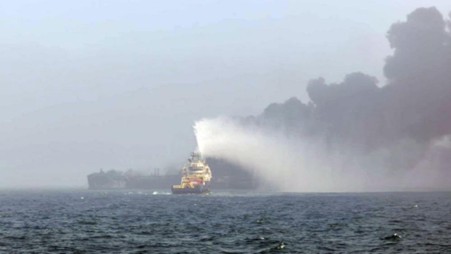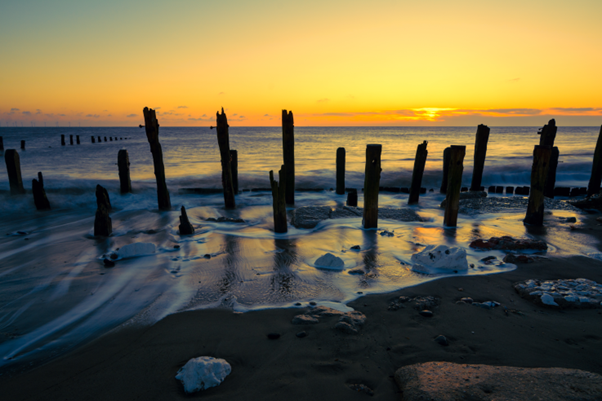An oil tanker and a cargo ship collided in the North Sea off the UK coast on Monday 10 March, triggering a major rescue mission.
UK authorities launched lifeboats and firefighting vessels to the scene some 10 nautical miles out from the city of Hull after an alarm was sounded.
“A coastguard rescue helicopter from Humberside was called, alongside lifeboats … an HM Coastguard fixed-wing aircraft, and nearby vessels with firefighting capability,” a coastguard spokesperson said.
Photo: Getty Images
The incident involved a US-registered oil tanker, Stena Immaculate, and a Portuguese container ship called the Solong, registered in Madeira, according to ship tracking website Vessel Tracker.
Photos and videos from the scene showed large clouds of smoke billowing out from the oil tanker after the ships collided on Monday morning, and the company which manages the Stena Immaculate reported “multiple explosions”. At around 22:00 GMT on Monday, the Coastguard said both vessels were still on fire.
One crew member on the Solong remained missing and the search for them has been called off, the rescue service said.
Another 36 crew members from both vessels were safely brought back to shore and one person was taken to hospital.
Multiple toxic hazards
Efforts to assess any environmental damage are still ongoing after it was confirmed some jet fuel had leaked into the sea off the Humber Estuary.
A US official confirmed the tanker had been carrying jet fuel “in support of the Department of Defense”. Jet fuel has a high boiling point, so it will evaporate slowly. It is also relatively toxic, so marine life that comes into contact with it may be killed. This type of fuel can be broken down in the water by bacteria and it appears from images some of it has already caught fire and been burnt off.
According to the National Oceanic and Atmospheric Administration, jet fuels are “relatively less acutely toxic than diesel.”
“Aquatic organisms that come in direct contact with naturally dispersed and entrained jet fuel in the water column may be killed. However, small spills in open water may not result in fish kills.”
The tanker was carrying 130,000 barrels of jet fuel. But that amount doesn’t account for the heavy diesel fuel powering the vessels themselves.
Downing Street said details of the cause of the collision were “still becoming clear”. The prime minister’s official spokesman said it was an “extremely concerning situation”.
He said: “We thank the emergency services for their rapid response. I understand the Department for Transport is working closely with the coastguard to help support the response to the incident.”
Photo: PA Media
Sodium cyanide
A Coastguard rescue helicopter was sent to the scene, as well as four lifeboats and nearby vessels with fire-fighting capability.
The cargo ship had been carrying 15 containers of the chemical sodium cyanide when it collided with the tanker.
Sodium cyanide has a variety of commercial uses, from being used to plate metals to dye production. It is highly soluble in water and can be toxic as it affects the uptake of oxygen. It is not clear whether any sodium cyanide from the cargo ship has leaked into the sea.
Dr Mark Hartl, associate professor of marine biology at Herriot Watt University, said sodium cyanide is very soluble in water and can be toxic because it interferes with the respiration of animals, but at this point it is not clear if any has entered the water.
Alastair Hay, professor of environmental toxicology at Leeds University, said there is a risk that some hydrogen cyanide gas might have been produced if the sodium cyanide came into contact with water. If this happened, the hydrogen cyanide “could present a risk to any of those involved in rescue”, Prof Hay added.
Dr Hartl said marine creatures have a major avoidance reaction so may have already vacated the affected area.
Marine ecology and conservation expert Dr Tom Webb said the chemical pollution resulting from incidents like this one “can directly impact birds, and it can also have long-lasting effects on the marine food webs that support them”.
Threat to Humber Estuary
The estuary is an internationally important area for wildlife, designated as a Special Area of Conservation (SAC), Special Protection Area (SPA), Site of Special Scientific Interest (SSSI), and an internationally important wetland under the Ramsar Convention.
Dave O’Hara, senior site manager at RSPB Bempton Cliffs said they were “extremely concerned” about the potential for an oil leak.
“As details continue to emerge, our first thoughts are for the safety of everyone on board and those responding to this incident,” he said.
“The East Coast is home to internationally important seabirds. The incident is also close to Bempton Cliffs, home to the biggest gannet colony in England.
“Naturally we are extremely concerned about the potential for a leak from the tanker as oil pollution can seriously damage habitats and be lethal to seabirds.
“We are keeping a close eye on this situation, and will work with the relevant marine authorities as is needed.”
‘Visibility was poor’
The Marine Accident Investigation Branch said a team of inspectors and support staff had started gathering evidence and was undertaking a preliminary assessment to determine its next steps. Divisional Commander Atkinson said: “An assessment of any required counter pollution response is being carried out by the Maritime and Coastguard Agency.”
The tanker was listed as sailing from the Greek port of Agioi Theodoroi, while the cargo vessel was on course from Grangemouth in Scotland to Rotterdam in the Netherlands.
The Stena Immaculate is the larger of two ships, listed as being 183 metres long and 32 metres wide. The Solong is 140.6 metres long and 21.8 metres wide, according to ship tracking site Marine Traffic.
UK Transport Secretary Heidi Alexander said she was “concerned” to hear of the collision between the two vessels. She thanked “all emergency service workers involved in their continued efforts in responding to the incident.”
The Met Office said visibility was poor in its morning forecast for Yorkshire and Humber. “Areas of fog and low cloud lifting as winds increase through the morning, with some warm, if rather hazy sunny spells expected in places for a time,” the weather agency said.


